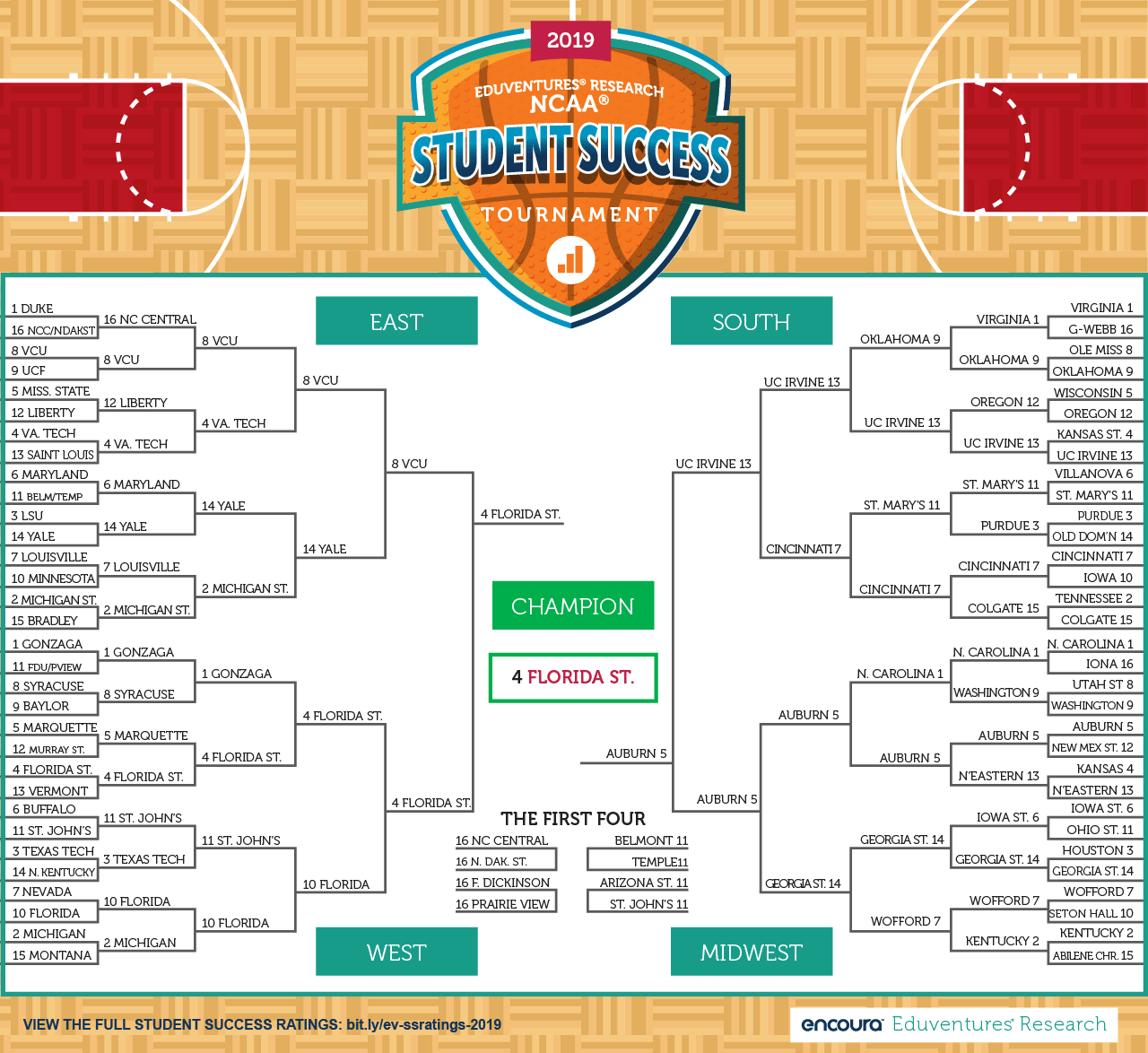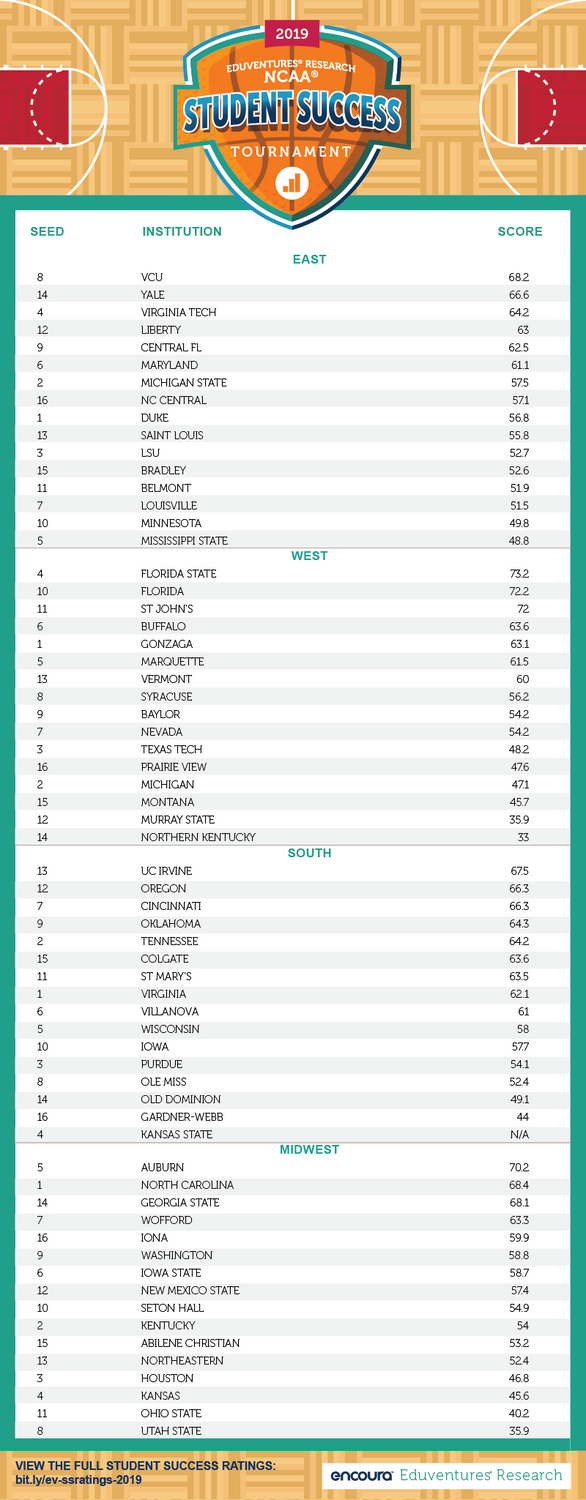When it comes to college basketball—or athletics in general—it’s all fun and games, unless your students aren’t successful. The intense focus on admissions and athletics in the news cycle over the last few weeks has raised serious questions about equity and fairness in college admissions.
By extension, this reflects on the constant drumbeat of questions about the quality of higher education for everyday students—a complex topic that we won’t fully explore here today. Instead, in this annual post, we’ll try to lighten the load with some college basketball “predictions”—only our bracket focuses on schools with the best records on student success.
We’ll start by reminding you, with tongue firmly in cheek, that each of the 68 institutions in the men’s NCAA tournament (and the women’s tournament, too) have a much more important level of performance to aspire to than athletics alone—performance on student success. If March Madness was about earning points on retaining and graduating students, which schools would come out on top?
Every year, we use the Eduventures Student Success Ratings to rate schools based on their student success records and identify best practice institutions. For more information on exactly how we do so, read about our methodology.
The most important thing to remember about our ratings is that they take into consideration a performance model of how your institutions “should” perform given the students you serve; they also take into consideration your historical trends. The ratings are not about absolute retention and graduation numbers.
For now, though, let’s play the NCAA tournament through as if Eduventures Student Success Ratings were basketball scores (Figure 1). You can see the full ranking of all 68 teams and their Student Success Scores at the end of this post.
Figure 1. (Click for full size)
With last year’s winner, Davidson College, out of the tournament this year, , winner of the West region, as the champion! The Seminoles take on the Auburn Tigers in the Edventures Student Success Ratings men’s basketball finals, besting them by three points in a high-scoring affair. Read about their matchup and more from each region below.
Road to the Final Four
East Region
In the East, overall odds-on favorite and number-one seed, Duke University (56.8), falls flat right out of the gate. It loses a close game to regional competitor North Carolina Central (57.1). This leaves the region wide open for eighth-seed Virginia Commonwealth (68) to take control. Virginia Commonwealth knocks out Central Florida (63), NC Central, Virginia Tech (65), and a surprisingly tough Yale (67) to make it to the Final Four.
West Region
The West was this year’s toughest region in that it had the top three rated teams in the tournament (based on Student Success Scores). This makes for terrible luck for Florida (72.2) and St. John’s (71.6) who perhaps play the closest high quality game of the tournament in the regional semi-finals. Florida just squeaks through only to lose to its in-state rival, Florida State (73), in the regional final.
Florida State’s path to victory includes two solid warm-up wins over Vermont (60) and Marquette (62). It knocks out number-one seed Gonzaga (63) before its thriller over Florida.
South Region
The South, though not as dangerous as the West, boasts the highest levels of overall student success performance. The median Student Success Score of all teams in the region is 62 compared to the East (57), West (54), and Midwest (56). The South Region Champion, UC Irvine (68), exhibits this consistent performance in its path to the title, knocking out Oregon (66), Oklahoma (64), and Cincinnati (66). Number-one seed, Virginia, just can’t muster the same level of consistency. It has an easy first round win over Gardner-Webb (44), but stumbles in an unexpected second round loss to Oklahoma (64).
Midwest Region
The Midwest region harbors another superstar in the guise of number-five seed, Auburn (70). Auburn tears up the region, advancing to the Final Four with two easy wins against New Mexico State (57) and Northeastern (52), and two absolute barn-burners against number-one seed University of North Carolina (68) and Cinderella-story Georgia State (68). Before Georgia State meets its match in Auburn it makes its run with a relatively easy draw against Houston (47), Iowa State (59), and Wofford (63).
The Bottom Line
What do our faux tournament results tell us about the schools represented in this year’s competition? Here are two quick take-aways from looking at the draw:
- Teams in the tournament run the gamut on student success performance. According to our model, a rating of 50 would be average. As you can see, we have many schools that do better than average and many teams that don’t meet that standard. There’s a real richness of understanding necessary to get at who is doing well. It’s not always the institutions you think might be doing well or poorly once all the context is taken into consideration.
- The Final Four are some of the top-performing institutions overall, not just among basketball schools. Florida State, Auburn, Virginia Commonwealth, and UC Irvine are all institutions that are well within the top performance-tier of schools in their categories among all institutions we rate. They demonstrate that top athletic performance and top student success performance are not necessarily anathema in the same institution.
But the question remains, and it is the same admissions question that burst forward in all its ugliness this past week: Are institutions treating athletes and the general student body on equal footing? For now, we hope you can use these Eduventures Student Success Ratings to identify best practice institutions and we hope you can enjoy watching some basketball!
Efforts to improve student success involve almost every constituent on campus and are among the most complex endeavors an institution can make. Institutions of different sizes with different student bodies and different missions must find contextually appropriate approaches. Even then, changing the institutional culture, prioritizing a new strategy, and executing targeted programs is challenging.
The Eduventures Student Success Ratings offer an excellent starting point for institutional self-management on student success. By identifying best practice examples, the Report can help institutions find their own way.
Join us on the Student Success Ratings webinar to learn:
- Insight into the methodology used to create the ratings system
- Which colleges and universities are beating the student success odds and why
- How institutions can use the ratings to examine their own student success efforts
Thank you for subscribing!



